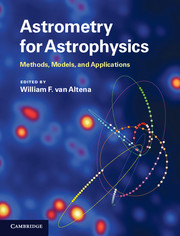Book contents
- Frontmatter
- Contents
- List of contributors
- List of acronyms
- Preface
- Part I Astrometry in the twenty-first century
- Part II Foundations of astrometry and celestial mechanics
- Part III Observing through the atmosphere
- Part IV From detected photons to the celestial sphere
- 13 Geometrical optics and astrometry
- 14 CCD imaging detectors
- 15 Using CCDs in the time-delay integration mode
- 16 Statistical astrometry
- 17 Analyzing poorly sampled images: HST imaging astrometry
- 18 Image deconvolution
- 19 From measures to celestial coordinates
- 20 Astrometric catalogs: concept, history, and necessity
- 21 Trigonometric parallaxes
- Part V Applications of astrometry to topics in astrophysics
- Index
- References
15 - Using CCDs in the time-delay integration mode
from Part IV - From detected photons to the celestial sphere
Published online by Cambridge University Press: 05 December 2012
- Frontmatter
- Contents
- List of contributors
- List of acronyms
- Preface
- Part I Astrometry in the twenty-first century
- Part II Foundations of astrometry and celestial mechanics
- Part III Observing through the atmosphere
- Part IV From detected photons to the celestial sphere
- 13 Geometrical optics and astrometry
- 14 CCD imaging detectors
- 15 Using CCDs in the time-delay integration mode
- 16 Statistical astrometry
- 17 Analyzing poorly sampled images: HST imaging astrometry
- 18 Image deconvolution
- 19 From measures to celestial coordinates
- 20 Astrometric catalogs: concept, history, and necessity
- 21 Trigonometric parallaxes
- Part V Applications of astrometry to topics in astrophysics
- Index
- References
Summary
Introduction
Time-delay integration (TDI), also known as drift scanning, is a mode of reading out a charge-coupled device (CCD) camera that allows a continuous image or scan of the sky to be recorded. Normally, most astronomers use CCDs in the point-and-shoot or stare mode. A telescope is pointed to a particular position of interest on the sky and made to track at that position. A shutter is opened to expose the CCD, and then closed while the electronic exposure recorded by the CCD is read out. In drift-scan mode, the telescope is parked, tracking is turned off, and the camera shutter is held open. As the sky drifts across the field, the electronic exposure recorded by the CCD is shifted across the pixel array, row by row, to match the drift rate of the sky. The time it takes a source in the field to drift across the whole array is the exposure time of the scan. Since the readout is continuous, this is the most time-efficient way to survey large areas of sky. There is no pause between exposures to wait for the readout of the camera. The largest-area photometric surveys to date have been made with drift-scanning cameras. Smaller-scale surveys have used drift scans for astrometry of faint standards, suitable for the re-calibration of the relatively imprecise positions of the large photometric and Schmidt-plate catalogs.
Charge-coupled device cameras were first used in drift-scan mode on ground-based telescopes beginning in the 1980s with the CCD Transit Instrument (McGraw et al. 1980) and the Spacewatch Telescope (Gehrels et al. 1986). These early instruments consisted of CCDs with field sizes of ∼10 arcmin, capable of covering 10–20 square degrees in a single scan. The Spacewatch camera was the first to use a CCD for automated detection of near-Earth asteroids (Rabinowitz 1991). The CCD Transit Instrument had two CCDs aligned east–west allowing simultaneous scans of the same field in two different passbands. Advancements in computer speed and capacity have since allowed the construction of much larger scanning cameras made up of CCD mosaics.
- Type
- Chapter
- Information
- Astrometry for AstrophysicsMethods, Models, and Applications, pp. 235 - 241Publisher: Cambridge University PressPrint publication year: 2012



